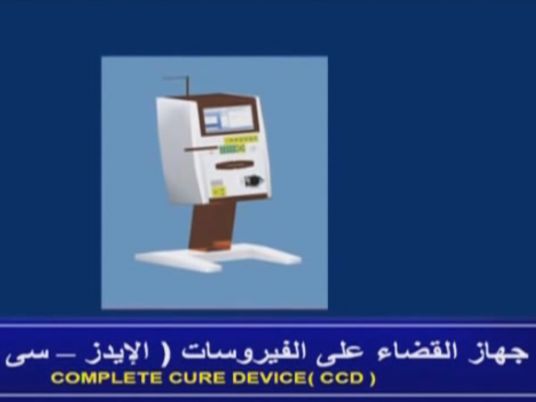
This Monday, 30 June, marks the day the Egyptian Armed Forces promised to start treating Hepatitis C and HIV/AIDS patients using its “Complete Cure Device". The supposed cure was heavily criticized in the scientific community and international press.
A recent undercover investigation by Egypt Independent into the scientific journal that touted the Egyptian military's “C-Fast”, non-invasive detection machine for Hepatitis C and HIV/AIDS, raises further concerns surrounding the efficacy, authenticity and safety of the device.
As part of the investigation, Egypt Independent's editors made up an obviously incoherent research paper: a merge of plagiarized material from previously published papers on mathematics and some Wikipedia articles. The paper was then sent to the academic journal called World Academy for Science, Engineering and Technology (WASET). In less than 24 hours, the paper was accepted and WASET congratulated the author.
After the good news reached our inbox, WASET, registered in Azerbaijan and ran from Turkey, prompted us to pay a fee of EUR 400 so that the paper gets published and potentially presented in conferences that the author would be invited to. While we did not do that, social media websites abound with complaints from enthusiastic scientists and researchers who have sent their papers to WASET, got published and were asked to pay a fee for an upcoming conference which they did, only to receive nothing in return.
Further research into such conferences proved that they do not exist to begin with. What WASET has been doing is: they copy-paste names of legitimate conferences and create spurious, counterfeit conferences with the same titles, same acronyms and same committees aiming to scam the academicians when they search for a particular conference via Google.
In a 90-minute video, debunking the science behind the “Complete Cure Device”, Egyptian virologist Islam Hussein of MIT explains that this invention, if true, would change the face of scientific history.
Such a breakthrough would easily be published in one of the high impact factor academic journals like Nature or Cell, Hussein said, but instead the paper was published in a journal whose website offers no clear history and almost no information about its impact factor.
Furthermore, according to Jeffrey Beall, an academic librarian at the University of Colorado, WASET is identified as a potential predatory publisher. A predatory publisher by definition is one that publishes non-peer reviewed and sometimes even hoax papers, for personal gain rather than pure scientific means.
“Well-respected hepatologists in the armed forces were not part of the research team that came up with the devices. They were not even informed about it before it was announced publicly,” Dr. Hassan Hamdy, professor of hepatology medicine at Ain Shams University, said. “We meet many of those doctors in conferences and when we ask them if they have heard anything about it, they say ‘not at all'. Why weren’t those well-established doctors part of the research and what is the reason behind the secretiveness even inside the armed forces itself?”
Government invests in hep C treatment
On 23 March, the Egyptian army’s research unit posted on its Facebook page a link to an online Google spreadsheet, titled “Registration form for Virus C and HIV/AIDS Patient,” for those wishing to book an appointment for treatment. A few hours later, the Facebook link was removed – but the Google form remains.
Youm7 news website reported on 1 June that the military research team had invented a pill that must be taken when being treated with the "Complete Cure Device".
A month earlier, according to Reuters, Egypt has obtained Sovaldi, the FDA -approved treatment for Hepatitis C from its US-based manufacturer Gilead Sciences at a striking 99 percent discount of its original price.
"We believe Sovaldi could have a major impact on public health in Egypt by significantly increasing the number of people who can be cured of Hepatitis C," Gregg Alton, head of corporate and medical affairs at Gilead, said in an emailed statement, according to Reuters.
It is unclear, however, why Egypt's government proceeded with its negotiation and chose to exhaust part of its GDP to buy the Sovaldi treatment, if it already invented the supposed inexpensive machine to cure the disease. Even at a 99 percent discount, Sovaldi will still cost USD 900 for a 12-week course of treatment.
Dr. Manal Hamdy Al-Sayed, Virus Eradication Committee member, told Youm7 that the Sovaldi deal has nothing to do with the armed forces' announcement of the "Complete Cure Device", adding that the negotiations were on-going since November of last year.
Military claiming success
The story started in late February when Egyptian media trumpeted the news that a military research team had succeeded in creating an accurate diagnosis tool for Hepatitis C and HIV/AIDS, that would not require the patient to draw blood. The device dubbed “C-Fast,” allegedly identifies an infected patient merely by pointing a metal rod at them.
For the average Egyptian, the device sounded quite impressive, particularly in a country with at least 10 million Hepatitis C patients, according to the World Health Organization.
Days after, the military researchers publicly announced a second machine that could cuff HIV/AIDS, Hepatitis C and according to various cavalier televised statements by members of the research team could cure any kind of virus, including H1N5, as well as skin diseases and even cancer, according to the doctors involved in the research. Quoting the official announcement video produced by the Egyptian armed forces, it could also detect red termites in palm trees.
With many doubting the authenticity of the devices and criticizing Egyptian media for trumpeting the inventions, some recalled Egypt's newspapers and magazines back during Nasser's presidency, when Al-Mosawwer magazine ran a cover page and a 14-page file on “Egypt's first space ship” back in the 50s. State-run Al-Ahram had also published a cover page headline hailing the invention of an unprecedented Egyptian rocket.
As the uniforms in the room during February’s press conference clapped, headed by then minister of defense Field Marshall Abdel-Fattah al-Sisi, now Egypt's president, the question remains: will the armed forces deliver on its promise to over 10 million Egyptians for a cure using its "Complete Cure Device" on June 30?




